
|   |

|   |
Glimpses of creative brilliance at a national dance festival - Dr. S.D. Desai e-mail: sureshmrudula@gmail.com Photos courtesy: Nrityabharati November 5, 2018 Nrityabharati's National Dance Festival, a three-day event in collaboration with ICCR, took off on Wednesday (Oct 24) on a high note at the Tagore Memorial Hall, Ahmedabad. It is mukha-abhinaya that made Dr. Jayaprabha Menon's three not very long solo Mohiniattam dance performances intelligible to the viewers, who keenly watched and gave her a standing ovation. A modest person offstage, she lets her learning sit lightly on her as a dancer. It only complements her chief pursuit of dance. She warms up the audience with a controlled body language on the stages of human life - childhood, playtime of early youth, gender attraction leading to marriage, time to be pensive and disenchanted in old age - in Adi Shankaracharya's dainty philosophical verbal gems in Bhaja Govindam, turned to Malayalam, very pleasingly set to music. With a sense of detachment the dancer conveyed the telling message of being away from illusory pleasures and surrendering to Govinda, the Lord, to be able to cross the ocean of life with bliss. A worthy disciple of Guru Bharati Shivaji, Jayaprabha demonstrates in Yashodhara how with originality a classical dancer draws fully from a rich tradition and can touch contemporary sensibility. With her nuanced abhinaya, she gives a feel of the great inner conflict leading to her enlightenment that the late Kavalam Panicker has seen and created in the padam Yashodhara with his own music. Yashodhara is a rare creative work of collaboration between the writer, music composer, choreographer and dancer. In Varsha, it is the sixth sense, the sensitive being within, of the performing artist that was seen responding lyrically to the raindrops her body receives. In this and the earlier dance pieces, Panicker's Sopanam music with its refreshing emulation of the sounds of nature and silences built in it is integrally complementary to the dance performance. Kerala is God's own country also in the sense that the creative response from the artists of this land is nearly as beauteous as the nature it is endowed with. 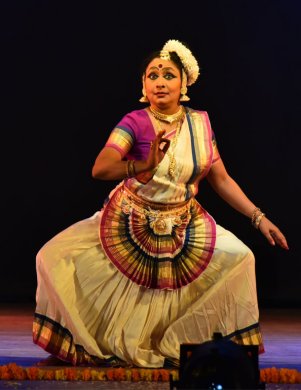 Jayaprabha Menon 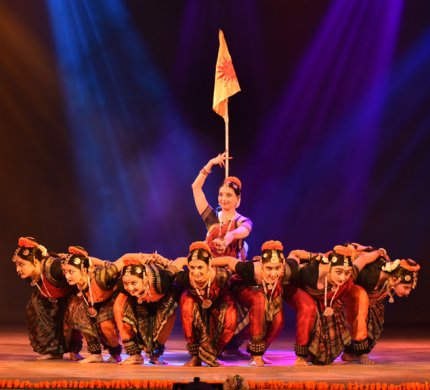 Nrityabharati Chandan and Nirali Thakore of Nrityabharati have developed a knack of conjuring up deities and their devotees through choreography based on authentic Sanskrit shlokas, chants and widely shared devotional lines in Gujarati. The performers are all in their teens or early twenties, including Nirali, who looks their age. In kaleidoscopic patterns young dancers now give a feel of elements of nature, now of the ambience of a temple with a couple of them forming arches with hands, one or two at the temple bell, a few offering flowers to the deity in deep in the centre with no image, standing still for more than a few seconds. Meticulous attention is paid to all minute details - costume designs, their colours, the aharya from top to the toe, symmetrical group formations, synchronization with the sounds, light effects according to the ambience, perfectly coordinated entries and exits, formations with girls one behind another and their hands giving an illusion of deities like Goddess Saraswati, Goddess Amba and Lord Shiva having multiple arms and their benevolent acts (Khushi, Aayushi, Riya and others). Sound patterns that create the ambience are limited but visuals are countless. Among the many episodes brilliantly portrayed by the hosts on Day One and Day Two were the electrifying one of the chariot of Soorya Dev being drawn by seven divine horses, the one of devotional significance Panchayatan Pooja and the endearingly familiar one Govinda Leela. 'Beauty of Nature', a revival, choreographed by Chandan Thakore was a choreographic work set in a moonlit night giving an idea of nocturnal beauty and movement in nature in silence on western piano notes, seen as though by two girls (Devanshi, Ishita). The guest dancer on Day Two was Shalini Khare, a young Kathak dancer from Jabalpur (MP). Even while appreciating her keen interest in Kathak since childhood and her continuing with it during formal studies in Engineering and Management, it needs to be noted that she would stand to gain if she observes good dancers and learns to let the body, mind and soul go into her movement. If a stately dignity in her stance, mudras and movement characteristic of the form complements her natural grace, has movement in sync more accurately with rhythm and if she brings tightness and clarity to hand gestures she has the potential to emerge a good dancer. Surprisingly, she danced on lousily recorded music. 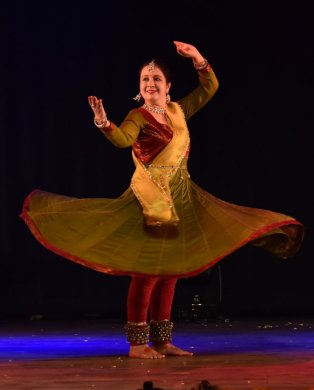 Shalini Khare 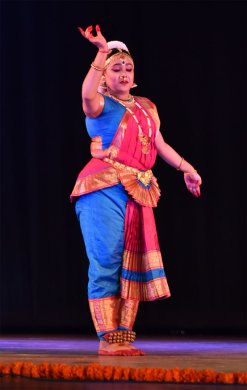 Arani Bhakta 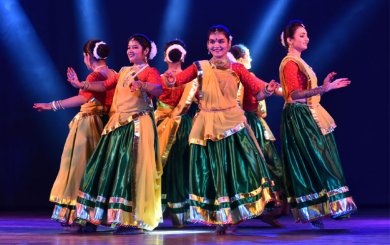 Kalakshetra, Bhavnagar 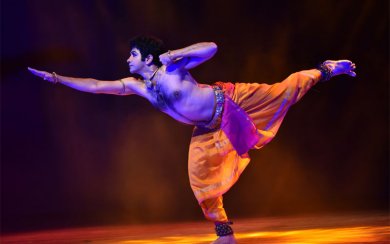 Pavitra Bhat Arani Bhakta, a young Bharatanatyam dancer from Bangladesh did Pranaumi - Pushpanjali and Tillana on Day Three. One felt good to see a group from Kalakshetra, Bhavnagar, of perhaps the country's most senior Kathak exponent Dharamshibhai Shah (1921-2017) led by Jigar Bhatt and Parul Sheth on stage and singer Jhaverben Shah in the audience. They danced Pranavaakar, Vasanta and Tarana on excellent recorded musical compositions by Ashit Desai. What is said in the preceding paragraph applies to these dancers as well though. There were parts which were relatively pleasing, Vasanta for example. How much of Kathak, however, with its verve and grace did they have in their feet, hands and body? ICCR supports good performing artists of India. For its consistent credibility, it would do well to have strict standards for empanelment. A noteworthy combination of a choreographer bestowed with creative imagination and a young dancer capable of translating the choreographer's vision to a Bharatanatyam performance giving wings to the viewer's imagination is found in Guru Deepak Mazumdar and his disciple Pavitra Bhat, who was invited by Nrityabharati for the third time to its festival. Pavitra did all Tulsi chopais of Hanuman Chalisa as a varnam with agility and flow. He visualizes all the traits portrayed by the Mahakavi with such seeming effortlessness, the character emerges as a hero having exceptional physical prowess, quick resourcefulness, dependable knowledge and unswerving bhakti for Lord Ram. Pavitra takes liberty neither with the text rendered in the traditional structure by vocalist Pustakam Rama, nor with the Bharatanatyam form. Considering the dramatic action involved, he welcomes and builds into his performance, punctuated and coordinated with nritta a couple of times, the lokadharmi style and strikes a balance with the nuanced codified natyadharmi style. The performance was aesthetically so satisfying to those discerning and appealing to the rest in its overflowing bhakti rasa that the audience rather than waiting till the end of the program, instantly on completion of the performance accorded the dancer a standing ovation. Dr. S.D. Desai, a professor of English, has been a Performing Arts Critic for many years. Among the dance journals he has contributed to are Narthaki, Sruti, Nartanam and Attendance. His books have been published by Gujarat Sahitya Academy, Oxford University Press and Rupa. After 30 years with a national English daily, he is now a freelance art writer. |